Abstract
Neurotoxicity is the major health effect from exposure to lead for infants and young children, and there is current concern regarding possible toxic effects of lead on the child while in utero. There is no placental-fetal barrier to lead transport. Maternal and fetal blood lead levels are nearly identical, so lead passes through the placenta unencumbered. Lead has been measured in the fetal brain as early as the end of the first trimester (13 weeks). There is a similar rate of increase in brain size and lead content throughout pregnancy in the fetus of mothers in the general population, so concentration of lead probably does not differ greatly during gestation unless exposure of the mother changes. Cell-specific sensitivity to the toxic effects of lead, however, may be greater the younger the fetus. Lead toxicity to the nervous system is characterized by edema or swelling of the brain due to altered permeability of capillary endothelial cells. Experimental studies suggest that immature endothelial cells forming the capillaries of the developing brain are less resistant to the effects of lead, permitting fluid and cations including lead to reach newly formed components of the brain, particularly astrocytes and neurons. Also, the ability of astrocytes and neurons to sequester lead in the form of lead protein complexes occurs only in the later stages of fetal development, permitting lead in maturing brain cells to interact with vital subcellular organelles, particularly mitochondria, which are the major cellular energy source. Intracellular lead also affects binding sites for calcium which, in turn, may affect numerous cell functions including neurotransmitter release.
Full text
PDF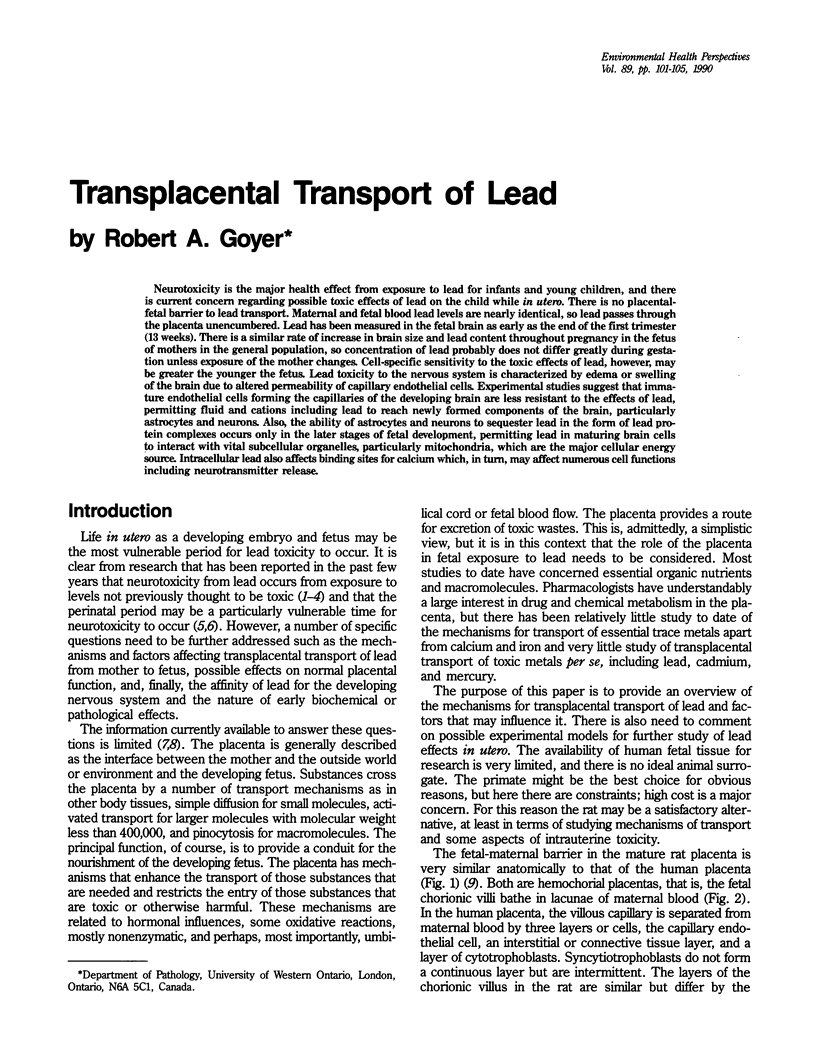
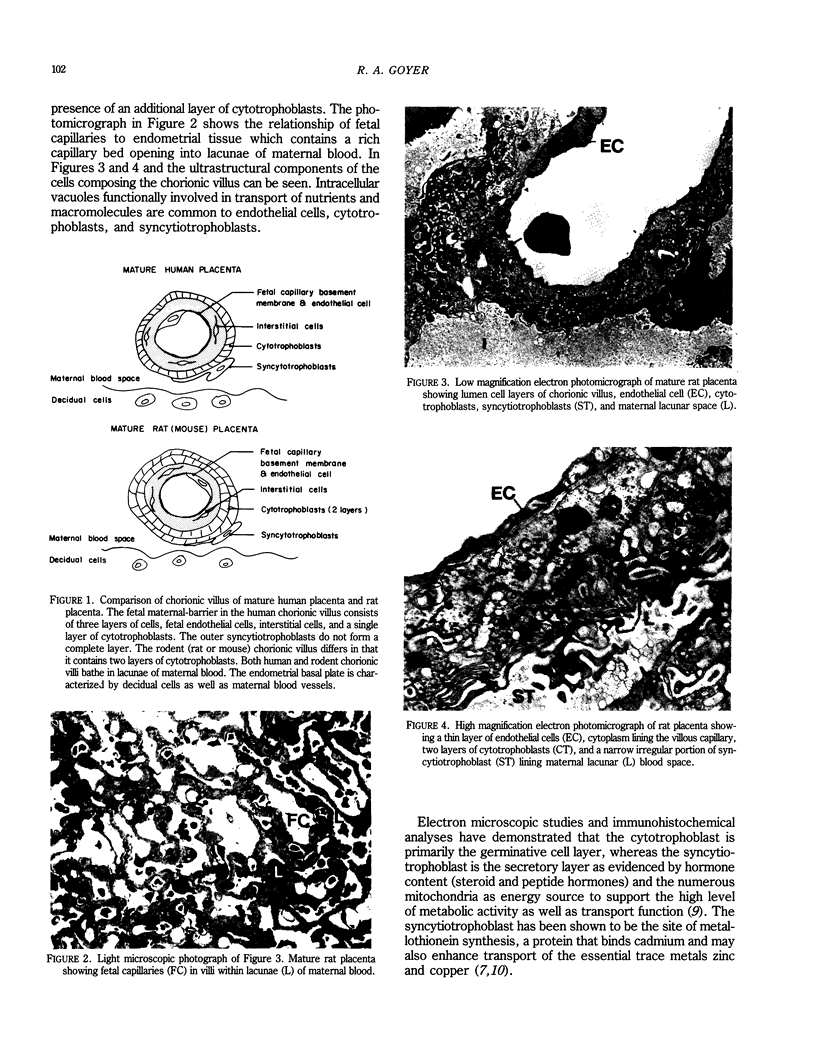
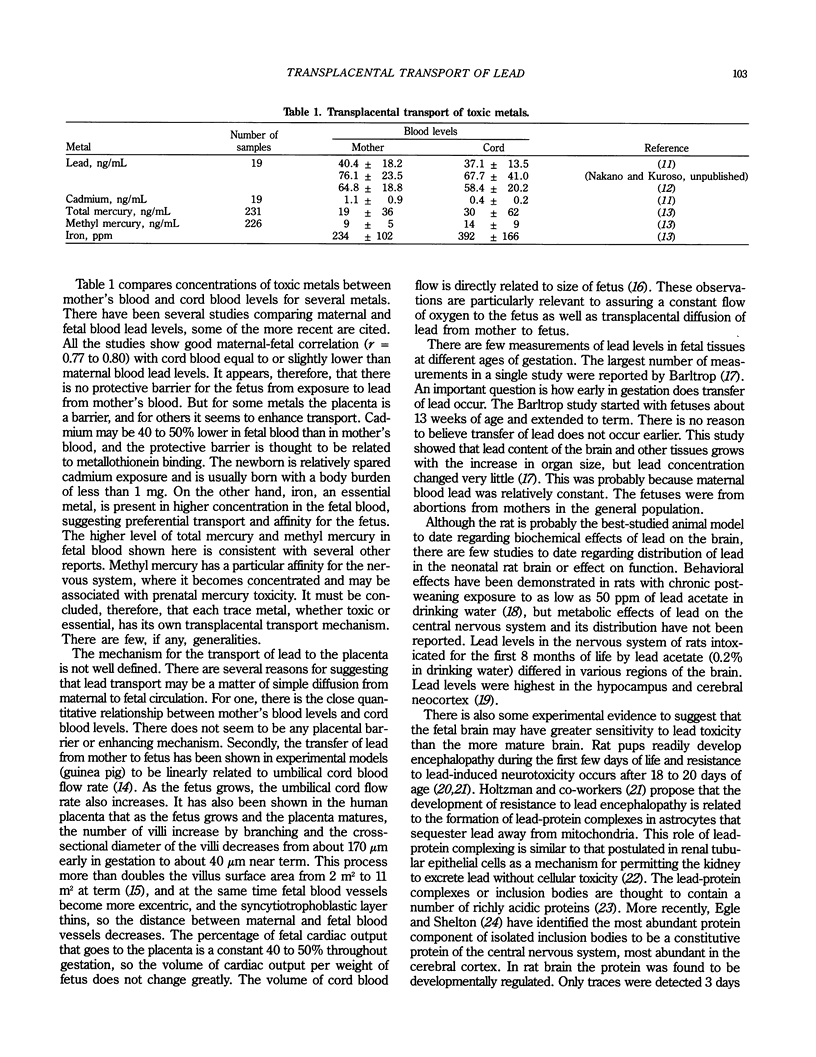
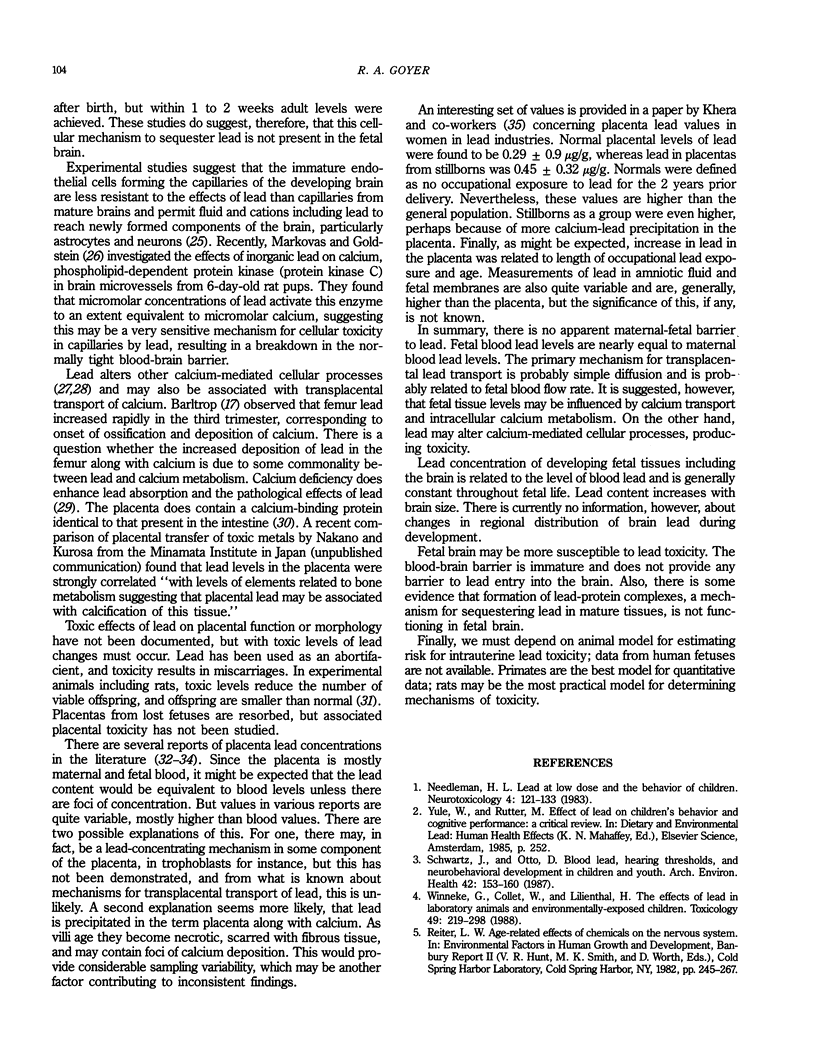
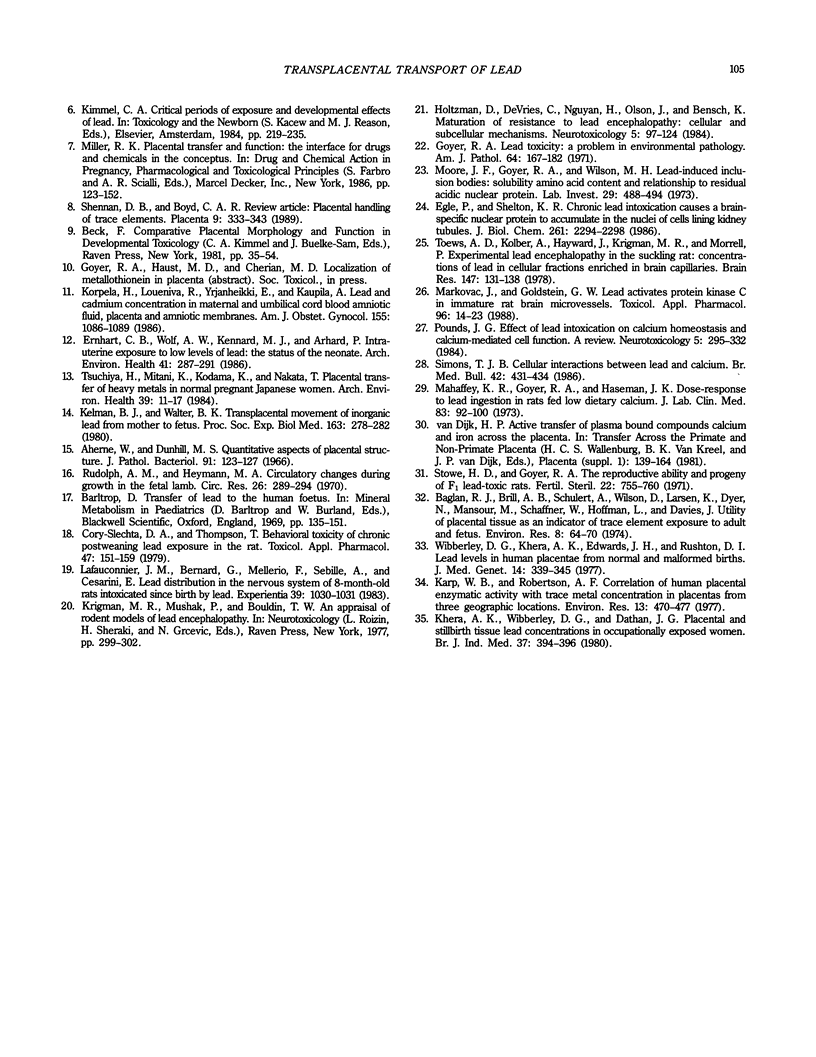
Images in this article
Selected References
These references are in PubMed. This may not be the complete list of references from this article.
- Baglan R. J., Brill A. B., Schulert A., Wilson D., Larsen K., Dyer N., Mansour M., Schaffner W., Hoffman L., Davies J. Utility of placental tissue as an indicator of trace element exposure to adult and fetus. Environ Res. 1974 Aug;8(1):64–70. doi: 10.1016/0013-9351(74)90063-2. [DOI] [PubMed] [Google Scholar]
- Cory-Slechta D. A., Thompson T. Behavioral toxicity of chronic postweaning lead exposure in the rat. Toxicol Appl Pharmacol. 1979 Jan;47(1):151–159. doi: 10.1016/0041-008x(79)90082-6. [DOI] [PubMed] [Google Scholar]
- Egle P. M., Shelton K. R. Chronic lead intoxication causes a brain-specific nuclear protein to accumulate in the nuclei of cells lining kidney tubules. J Biol Chem. 1986 Feb 15;261(5):2294–2298. [PubMed] [Google Scholar]
- Ernhart C. B., Wolf A. W., Kennard M. J., Erhard P., Filipovich H. F., Sokol R. J. Intrauterine exposure to low levels of lead: the status of the neonate. Arch Environ Health. 1986 Sep-Oct;41(5):287–291. doi: 10.1080/00039896.1986.9936698. [DOI] [PubMed] [Google Scholar]
- Goyer R. A. Lead toxicity: a problem in environmental pathology. Am J Pathol. 1971 Jul;64(1):167–182. [PMC free article] [PubMed] [Google Scholar]
- Holtzman D., DeVries C., Nguyen H., Olson J., Bensch K. Maturation of resistance to lead encephalopathy: cellular and subcellular mechanisms. Neurotoxicology. 1984 Fall;5(3):97–124. [PubMed] [Google Scholar]
- Karp W. B., Robertson A. F. Correlation of human placental enzymatic activity with trace metal concentration in placentas from thres geographical locations. Environ Res. 1977 Jun;13(3):470–477. doi: 10.1016/0013-9351(77)90026-3. [DOI] [PubMed] [Google Scholar]
- Kelman B. J., Walter B. K. Transplacental movements of inorganic lead from mother to fetus. Proc Soc Exp Biol Med. 1980 Feb;163(2):278–282. doi: 10.3181/00379727-163-40762. [DOI] [PubMed] [Google Scholar]
- Khera A. K., Wibberley D. G., Dathan J. G. Placental and stillbirth tissue lead concentrations in occupationally exposed women. Br J Ind Med. 1980 Nov;37(4):394–396. doi: 10.1136/oem.37.4.394. [DOI] [PMC free article] [PubMed] [Google Scholar]
- Lefauconnier J. M., Bernard G., Mellerio F., Sebille A., Cesarini E. Lead distribution in the nervous system of 8-month-old rats intoxicated since birth by lead. Experientia. 1983 Sep 15;39(9):1030–1031. doi: 10.1007/BF01989787. [DOI] [PubMed] [Google Scholar]
- Mahaffey K. R., Goyer R., Haseman J. K. Dose-response to lead ingestion in rats fed low dietary calcium. J Lab Clin Med. 1973 Jul;82(1):92–100. [PubMed] [Google Scholar]
- Markovac J., Goldstein G. W. Lead activates protein kinase C in immature rat brain microvessels. Toxicol Appl Pharmacol. 1988 Oct;96(1):14–23. doi: 10.1016/0041-008x(88)90242-6. [DOI] [PubMed] [Google Scholar]
- Moore J. F., Goyer R. A., Wilson M. Lead-induced inclusion bodies. Solubility, amino acid content, and relationship to residual acidic nuclear proteins. Lab Invest. 1973 Nov;29(5):488–494. [PubMed] [Google Scholar]
- Needleman H. L. Lead at low dose and the behavior of children. Neurotoxicology. 1983 Fall;4(3):121–133. [PubMed] [Google Scholar]
- Pounds J. G. Effect of lead intoxication on calcium homeostasis and calcium-mediated cell function: a review. Neurotoxicology. 1984 Fall;5(3):295–331. [PubMed] [Google Scholar]
- Rudolph A. M., Heymann M. A. Circulatory changes during growth in the fetal lamb. Circ Res. 1970 Mar;26(3):289–299. doi: 10.1161/01.res.26.3.289. [DOI] [PubMed] [Google Scholar]
- Schwartz J., Otto D. Blood lead, hearing thresholds, and neurobehavioral development in children and youth. Arch Environ Health. 1987 May-Jun;42(3):153–160. doi: 10.1080/00039896.1987.9935814. [DOI] [PubMed] [Google Scholar]
- Shennan D. B., Boyd C. A. Placental handling of trace elements. Placenta. 1988 May-Jun;9(3):333–343. doi: 10.1016/0143-4004(88)90041-0. [DOI] [PubMed] [Google Scholar]
- Simons T. J. Cellular interactions between lead and calcium. Br Med Bull. 1986 Oct;42(4):431–434. doi: 10.1093/oxfordjournals.bmb.a072162. [DOI] [PubMed] [Google Scholar]
- Stowe H. D., Goyer R. A. Reproductive ability and progeny of F 1 lead-toxic rats. Fertil Steril. 1971 Nov;22(11):755–760. [PubMed] [Google Scholar]
- Toews A. D., Kolber A., Hayward J., Krigman M. R., Morell P. Experimental lead encephalopathy in the suckling rat: concentration of lead in cellular fractions enriched in brain capillaries. Brain Res. 1978 May 19;147(1):131–138. doi: 10.1016/0006-8993(78)90777-1. [DOI] [PubMed] [Google Scholar]
- Tsuchiya H., Mitani K., Kodama K., Nakata T. Placental transfer of heavy metals in normal pregnant Japanese women. Arch Environ Health. 1984 Jan-Feb;39(1):11–17. doi: 10.1080/00039896.1984.10545827. [DOI] [PubMed] [Google Scholar]
- Wibberley D. G., Khera A. K., Edwards J. H., Rushton D. I. Lead levels in human placentae from normal and malformed births. J Med Genet. 1977 Oct;14(5):339–345. doi: 10.1136/jmg.14.5.339. [DOI] [PMC free article] [PubMed] [Google Scholar]
- Winneke G., Collet W., Lilienthal H. The effects of lead in laboratory animals and environmentally-exposed children. Toxicology. 1988 May;49(2-3):291–298. doi: 10.1016/0300-483x(88)90011-x. [DOI] [PubMed] [Google Scholar]





